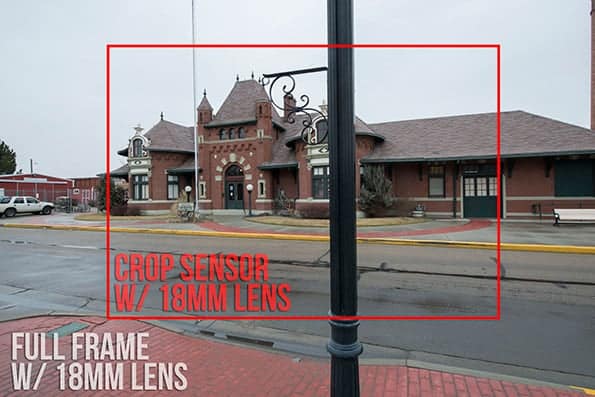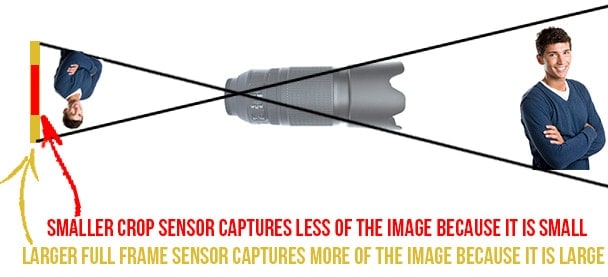When photographers are interested in buying a full frame camera for the first time as an upgrade from their crop frame DSLR, they often have a nagging question. Most photographers have heard there is a difference in the field of view (how much of the scene you can see) when using the same focal length of camera on either a crop frame or full frame camera. So, they want to know how much of a difference it will make.
If you're brand new to this concept, you can check out this article, where I discuss the difference between crop and full frame sensors.
They usually aren't sure how to phrase this question, so they ask something like these questions:
- Do you have any comparison photos of the mm difference between crop frame and full frame cameras?
- I know my crop sensor camera is cutting off some of the picture, but how much?
- What does a picture look like at 18mm on a crop frame camera, compared to 18mm on a full frame camera?
Field of View, and How it is Impacted by the Crop Factor
Field of view simply means the amount of the scene that you can capture in one frame. A full frame sensor is physically larger than a smaller crop frame APS-C sized sensor. This physical difference in the size of the sensor changes the physics of how the lens focuses the image on the sensor. The larger sensor captures more field of view than the crop frame camera if all else is equal.
The sample picture below shows a picture taken at 18mm on a crop sensor camera, and the same picture at 18mm on a full-frame camera. The difference is quite surprising.

Focal Length Equivalents
Please keep in mind that not all crop sensor DSLRs have the same size sensor. The crop factor on APS-C crop sensor DSLRs from Pentax, Olympus, Sony, and Nikon is 1.5. The crop factor for most Canon DSLRs is 1.6x. That means that if you take an 18mm lens and put it on a Canon and Nikon, the Canon picture will be slightly more zoomed in.
On the table below showing the equivalent focal lengths of a full frame and crop sensor camera, I have used the more common 1.5x crop factor. Canon cameras will be ever so slightly more zoomed in than even what the table shows.

According to the table above, for example, you would have to use a 75mm lens on a full frame camera in order to get a photo with the exact same field of view as a photo from a crop sensor camera shooting at 50mm.
WHY Does the Sensor Size Change the Field of View?
Physics, that's why! Remember that the job of the lens is to take a scene and focus it to a small area. The lens creates the reflected scene and puts it on the image sensor, which records the light focused by the lens. Naturally, the larger the sensor is, the more of the focused image it can see. If you're more of a visual learner, check out the picture below that explains the concept.

If you'd like to learn more about how your camera works and the basics of photography, you might consider taking my 30-Day Beginning Online Photography Class.
So is Full Frame Worth the Extra Cost?
It depends on what type of photography you're doing. It's easy to say that full frame is better, but that's not necessarily true. For example, if you don't have the money to plunk down on extremely expensive super telephoto lenses, then you may want the crop factor of a crop sensor camera to help you shoot wildlife or sports. If you're a landscape photographer, then you may want to spend the extra money on a full frame camera to help you go wider.
If you are in the market for a full frame camera, however, you should really take a long hard look at the Canon 6D or the Nikon D600. These cameras are only a few months old and are MUCH less expensive than full frame cameras have traditionally been.

Hello. I wanted to use a 28mm prime lens on the “Super 35mm” Black Magic production camera sensor. But, having realized that the sensor is cropped, apparently 1.7x, I am considering using an 18mm prime lens. My question is, what do I lose by adjusting the lens to the sensor? Will I literally get the same image with the 18mm on a cropped sensor? Or will I lose something? Thanks so much for your help.
I have a question. Let’s say I have a Arri Alexa camera (super35 sensor) and Zeiss Master Prime 35mm lens. We have a depth of field. Then, we change the lens with Sigma Art 35mm(full frame). Does the field of view change?
Am i right to say the scene/width of the picture i will get from a 18mm on aps-c is the same as 27mm on full frame?? though it may be a silly question but it’s important to me as i am now hesitating on which one to buy.. if 27mm lens on full frame shows the same as 18mm lens on aps-c, theres no point on spending more on full frame. as the width of the picture is my priority. thanks!
If you spend your money, let’s say on a Canon EOS 5D MK III (full frame) and a EOS 7D MK II (APS-C/1.6x crop) then take them out on a test to see which is better tripod mounted and same lens (I’ve done this) after crop equivalent, and remember (my results prove this) Canon and Nikon (or others) don’t give away their technologies! The Canon EOS 5D MKIII vs. the Canon EOS 7D MK II deep field study (zoomed way in until the image starts to come apart (pixelate), the 5D MK III is far better. And remember that we haven’t even gotten into noise factors of the sensor yet and CPU’s ability to remove that noise and maintain sharpness. The 5D MK III sensor for that matter is more sensitive, with the ability to grab and resolve more detail with each pixel and the processors’ ability to compile the group of pixels into step changes in luminosity and color depth than the EOS 7D MK II. That leads to another question about which is better, something like a Canon EOS 1Dx (or the MK II) with 18 megapixels (or 20mp for the MK II) or the EOS 5D MK III with a 22.3 mp sensor. I think your readers might be surprised with the results. But to be fair, I don’t have that higher end camera. But I did have the 1Ds MK III and the 5D MKII (that’s mk 2 not mk 3) and I found the 5D MK II sensor deep field output quite comparable to the 1Ds MK III so much so that I got rid of the 1Ds MK III for the 5D MK III which was the better choice for deep crops of birding and wildlife photography comparing noise results to the EOS 1Ds MK III and if not the noise, the more softness (because of noise reduction in the processor).
Again the camera manufactures don’t give anything away for free.
I could not (easily) find this answer to my question on which was better so I had to prove this point one on one to myself.
With all that said, the Canon EOS 7D MK II speed (10fps) and AF system is better than that in the 5D MK III. Canon will have to up the ante on those two items along with improved ISO on the new rumored 5Dx/5DMK IV for me to consider that offering leaving my EOS 5D MK III behind. Then where does that leave the owners of the 1Dx MK II? Canon won’t shoot themselves in the foot. I’ve got a feeling I will be with my EOS 5D MK III for a while longer. After all it does a great job at what I need it to do. Maybe the new MK III version of the 7D will be far enough in the future to allow for the new 1Dx MKII users time to ready themselves for that next generation making room for what I want in a new an improved upgrade NOW for the 5Dx/5D MK IV!
Can anyone answer this simple question? Which will give the best photo for an 85mm full-body photo
1) FX full-frame 85mm lens on a full-frame camera
or
2) Exact same FX lens on a DX crop-sensor where I simply move back a few feet to get the same framed shot?
I understand moving back will change a few things such as slightly less bokeh blur but will backing up with a full-frame lens on a crop-sensor camera still give me that beautiful “85mm look” I love?
I want to buy the D500 and use 85mm lens but don’t really want to have to use a 58mm FX lens with equiv. focal 87mm DX focal length. The only DX 85mm for Nikkon has a large 3.5 aperture, I want to use the FX 85 1.8 aperture for more light in dim areas and more bokeh. But to get the 85mm frame that looks nice I would have to back up further. Will this result in an inferior photo for various reasons?? If so, then I guess I should rather just by a full-frame like the 810. Thanks for advice!!